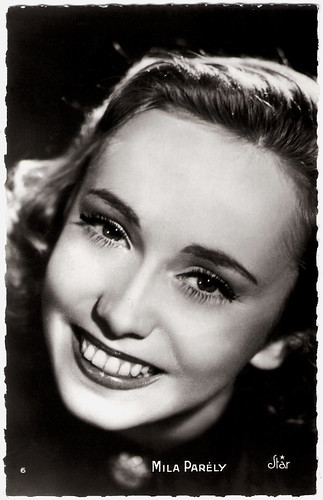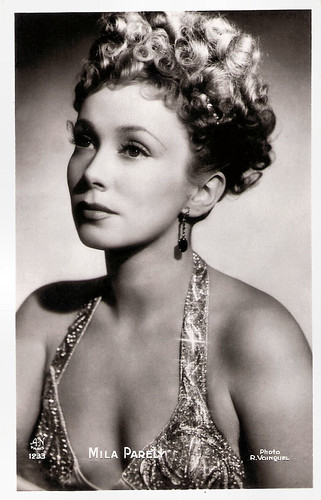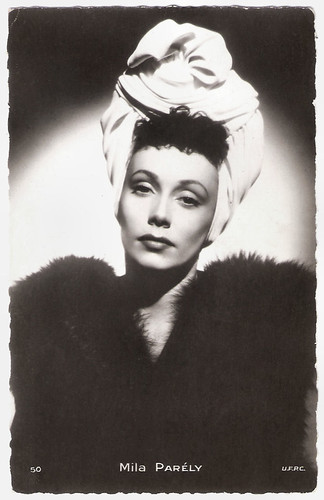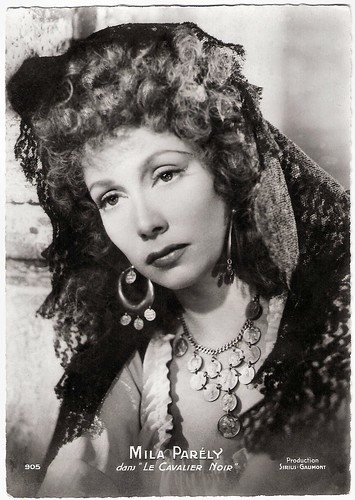
French postcard by Edition P.I., Paris, no. 6. Photo: Star.
One of the greatest films in the history of cinema
Mila Parély was born as Olga Colette Peszynsky in Paris in 1917. She was of Polish ancestry.
In 1932 Parély started her career in the short film Vive le sport/The Freshman, now considered as lost. In the following years she played several small roles, like a typist in the fantasy Liliom (Fritz Lang, 1934), ‘Marceline’ in Mister Flow (Robert Siodmak, 1936), a dancing girl in Le drame de Shanghaï/The Shanghai Drama (Georg Wilhelm Pabst, 1938), and a servant in Remontons les Champs-Élysées (Sacha Guitry, 1938). During this period, she also worked as a singer and made an American tour with the orchestra of Rudy Vallee.
She had her breakthrough in the cinema as Geneviève, the mistress of married Robert (Marcel Dalio) in La Règle du jeu/The Rules of the Game (Jean Renoir, 1939). Renoir’s masterpiece is a comedy of manners that depicts members of upper-class French society and their servants just before the beginning of World War II, showing their moral callousness on the eve of impending destruction.
La Règle du jeu was the most expensive French film up to that time, with its original budget of 2.5 million francs increased to five million, but it proved to be a critical and financial disaster. Although the original negative was destroyed in World War II, La Règle du jeu was restored under Renoir's supervision to its original length (minus one short scene) in the late 1950s, debuting to great acclaim at the 1959 Venice Film Festival. Since then La Règle du jeu has often been called one of the greatest films in the history of cinema.
Another interesting film was Les anges du péché/Angels of Sin (1943), the first feature film directed by Robert Bresson. Parély also appeared in the drama Le Lit à colonnes/The Four-poster (Roland Tual, 1942), starring Fernand Ledoux and Jean Marais.
She was engaged to the handsome Marais in 1942 but they separated in 1944. Jean Marais was homosexual and the long-term lover of French poet and filmmaker Jean Cocteau. Cocteau blessed their proposed marriage, because he wanted Marais to be happy. After their separation Parély and Marais co-starred in Cocteau’s romantic fantasy La Belle et la Bête/Beauty And The Beast (Jean Cocteau, 1946). Parély played the sister of Belle (Josette Day).
Mark Pittillo at AllMovie: “[Jean Cocteau] gives the film a shimmering, romantic look, and the brilliant costume and set design. The Beast's makeup, in particular, works beautifully; it's just realistic enough to be convincing, while allowing Marais to emote through his eyes and subtle facial tics. The unforgettable sets, which include human-arm candelabras and moving statues, are a marvel of impressionistic romanticism, filled with symbolism that hints at the story's darker implications. Forget Disney -- this is the closest anyone's come to capturing the essence of a fairy tale on film.”

French postcard by A. Noyer (A.N.), Paris, no. 1233. Photo: R. (Raymond) Voinquel.

French postcard by E. C., Paris, no. 105. Photo: Pathé.
A small-town whorehouse
In 1947, Mila Parély married Scottish racing driver Tomas ‘Taso’ Mathieson. Between 1930 and 1955, he entered more than 30 races, including multiple times the 24 Hours of Le Mans. The couple would stay together till his death in 1991.
Parély continued to play supporting parts in French and British films like Dernier refuge/Last Refuge (Marc Maurette, 1947), based on Le Locataire by Georges Simenon, the British thriller Snowbound (David MacDonald, 1948) starring Dennis Price, and the drama Mission à Tanger/Mission in Tangier (André Hunebelle, 1949) starring Raymond Rouleau.
Her best film of the 1950s is the anthology Le Plaisir/House of Pleasure (1952) directed by Max Ophüls and based on three stories by Guy de Maupassant. In the episode La Maison Tellier, Parély played one of the employees of a small-town whorehouse, who go out on for a day to the country to visit the communion of the niece of the Madame. She also played the female lead in the British crime film Blood Orange/Three Stops to Murder (Terence Fisher, 1953) opposite Tom Conway.
After that she only worked for television and played in the thriller Jet Storm (Cy Endfield, 1958), but her footage ended on the floor of the editing room. In the late 1950s, Parély retired in order to take care of her husband Taso Mathieson, who had been seriously injured in a near-death accident.
After living in England and Portugal, they moved to Vichy, France, where Parély organized several cultural and artistic events. Mathieson concentrated on his writing and his collection of photographs, together with Parély. He wrote various authoritative books, including Grand Prix Racing 1906-1914.
In the late 1980s, Parély returned to acting briefly. She played a countess in the film Comédie d'été/Summer Interlude (Daniel Vigne, 1989) with Maruschka Detmers, and also appeared in a TV film. In 1997 followed her final role in a short film, just like how her career had started.
Mila Parély died in 2012, aged 94, in Vichy.

French postcard by Editions E.C., Paris, no. 50. Photo: U.F.P.C.

French postcard by Edition d'Art BelFrance, no. 905. Photo: Sirius-Gaumont. Publicity still for Le cavalier noir/The black knight (Gilles Grangier, 1945).
Sources: Mark Pittillo (AllMovie), Yvan Foucart (Les Gens du Cinéma - French), Wikipedia (French and English) and IMDb.
No comments:
Post a Comment